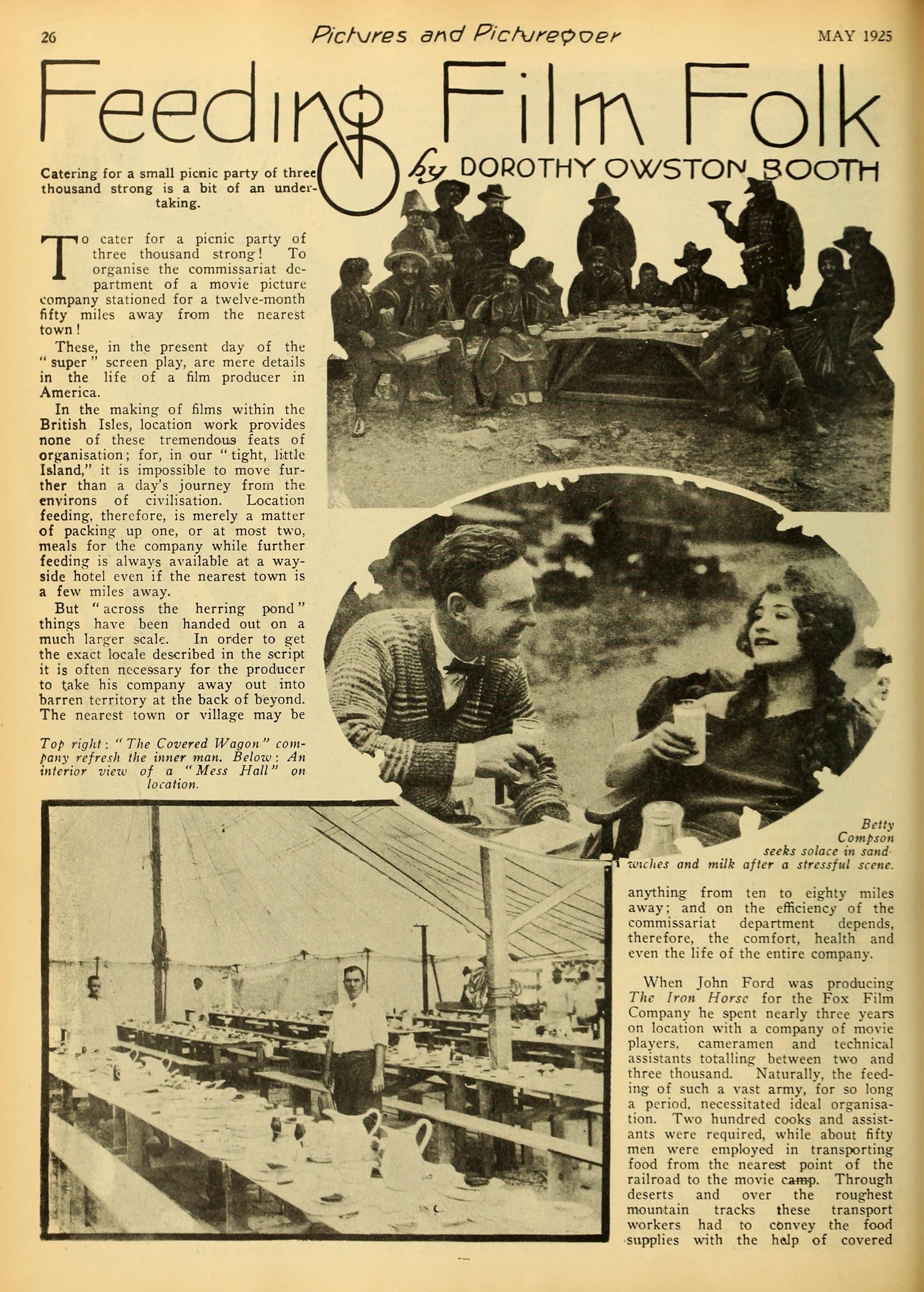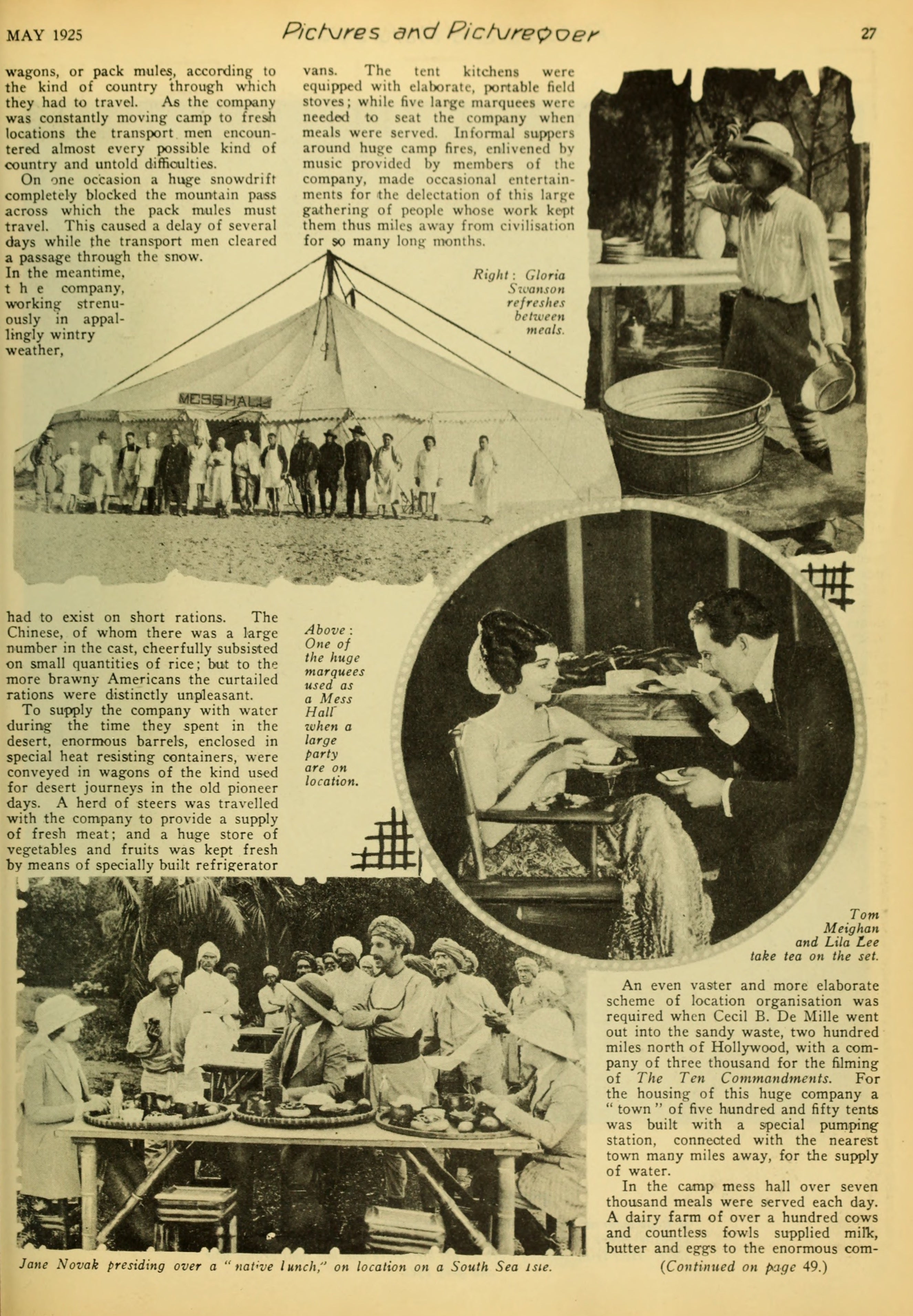Feeding Film Folk (1925) 🇬🇧

To cater for a picnic party of three thousand strong! To organise the commissariat department of a movie picture company stationed for a twelve-month fifty miles away from the nearest town!
These, in the present day of the “super” screen play, are mere details in the life of a film producer in America.
In the making of films within the British Isles, location work provides none of these tremendous feats of organisation; for, in our “tight, little Island,” it is impossible to move further than a day’s journey from the environs of civilisation. Location feeding, therefore, is merely a matter of packing up one, or at most two, meals for the company while further feeding is always available at a wayside hotel even if the nearest town is a few miles away.
But “across the herring pond” things have been handed out on a much larger scale. In order to get the exact locale described in the script it is often necessary for the producer to take his company away out into barren territory at the back of beyond. The nearest town or village may be anything from ten to eighty miles away: and on the efficiency of the commissariat department depends, therefore, the comfort, health and even the life of the entire company.
When John Ford was producing The Iron Horse for the Fox Film Company he spent nearly three years on location with a company of movie players, cameramen and technical assistants totalling between two and three thousand. Naturally, the feeding of such a vast army, for so long a period, necessitated ideal organisation. Two hundred cooks and assistants were required, while about fifty men were employed in transporting food from the nearest point of the railroad to the movie camp. Through deserts and over the roughest mountain tracks these transport workers had to convey the food supplies with the help of covered wagons, or pack mules, according to the kind of country through which they had to travel. As the company was constantly moving camp to fresh locations the transport men encountered almost every possible kind of country and untold difficulties.
On one occasion a huge snowdrift completely blocked the mountain pass across which the pack mules must travel. This caused a delay of several days while the transport men cleared a passage through the snow. In the meantime, the company, working strenuously in appallingly wintry weather, had to exist on short rations.
The Chinese, of whom there was a large number in the cast, cheerfully subsisted on small quantities of rice; but to the more brawny Americans the curtailed rations were distinctly unpleasant.
To supply the company with water during the time they spent in the desert, enormous barrels, enclosed in special heat resisting containers, were conveyed in wagons of the kind used for desert journeys in the old pioneer days.
A herd of steers was travelled with the company to provide a supply of fresh meat; and a huge store of vegetables and fruits was kept fresh by means of specially built refrigerator vans.
The tent kitchens equipped with elaborate, portable field stoves; while five large marquees were needed to seat the company when meals were served. Informal suppers around huge camp fires, enlivened by music provided by member of the company, made occasional entertainments for the delectation of this large gathering of people whose work kept them thus miles away from civilisation for so many long months.
An even vaster and more elaborate scheme of location organisation was required when Cecil B. De Mille [Cecil B. DeMille] went out into the sandy waste, two hundred miles north of Hollywood, with a company of three thousand for the filming of The Ten Commandments. For the housing of this huge company a “town” of five hundred and fifty tents was built with a special pumping station, connected with the nearest town many miles away, for the supply of water.
In the camp mess hall over seven thousand meals were served each day. A dairy farm of over a hundred cows and countless fowls supplied milk, butter and eggs to the enormous commissariat department. In one day this big movie family consumed seven hundred pounds of sugar; one thousand pounds of potatoes; nine hundred pounds of butter; nearly two thousand pounds of meat; over a thousand gallons of tea and coffee; nearly two thousand pounds of bread; four thousand eggs and a hundred gallons of tinned fruit!
Great hardship was occasioned to the Paramount Company which went out on location for the making of The Covered Wagon. During most of the time the company was eighty miles from the nearest town, and owing to several sand storms, quantities of food was ruined. The sand, mixed with a bitter alkali dust, penetrated into kitchen tents as well as into the sleeping tents and dressing rooms, and every article of food not enclosed in air tight tins was spoilt in five minutes from the commencement of the storm. Lois Wilson has since declared that she grew so accustomed to the addition of sand with all her food that she quite missed it when they moved to a colder location! Then, instead of sand, the intrepid players encountered frost, snow and ice. So intense was the cold, in fact, that a cup of boiling hot coffee was reduced to a solid, frozen mass in about three minutes.
Jane Novak tells of a strange meal she was once forced to take while away on location in the South Sea Islands. The native chieftain insisted on acting as host to the whole company for lunch; and a weird and wonderful repast was set before the movie actors. Each guest’s lunch was served on a large circular bamboo tray, and consisted of bowlfuls of cold, boiled rice; a weird concoction of long tuberous roots and succulent bamboo shoots; a strange kind of native bread; and fruits of various kinds, some of which, being previously quite unknown to the American players, needed explanation by the host. Jane declares that the meal itself was quite enjoyable but the fierce-looking native servants, of whom there was a vast number, were most terrifying and embarrassing!
Alice Terry and her company, while making exteriors for a recent film, spent several weeks in the desert at the very hottest time of the year. Work was commenced about seven o’clock each morning so that the company could rest during the almost unendurable mid-day hours, the cameras becoming busy again in the cooler evening. In order that the company should be able to keep perfectly fit under such unusual conditions the director decreed that a strict vegetarian diet must be the order of the day. Fruits and green vegetables, therefore, composed the meals, and these commodities were obtained by express carriers from the nearest village many miles away.

Top right: The Covered Wagon company refresh the inner man.
Below: An interior view of a “Mess Hall” on location.
Betty Compson seeks solace in sandwiches and milk after a stressful scene.

Above: One of the huge marquees used as a Mess Hall when a large party are on location.
Right: Gloria Swanson refreshes between meals
Jane Novak presiding over a “native lunch,” on location on a South Sea isle.
Tom Meighan and Lila Lee take tea on the set.

Collection: Picturegoer Magazine, May 1925
